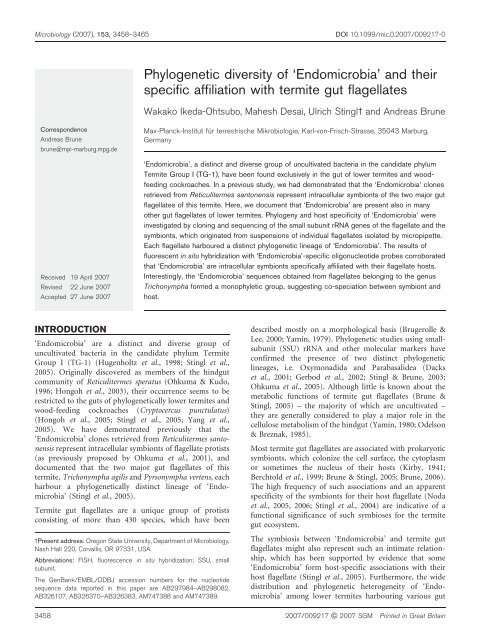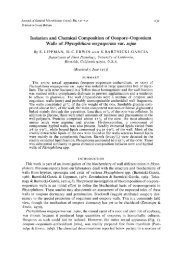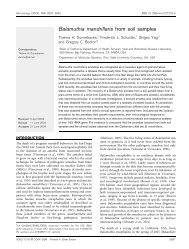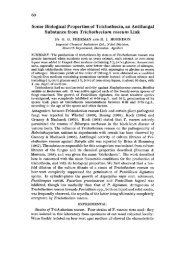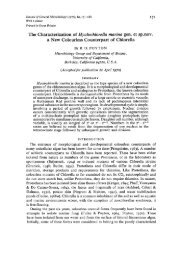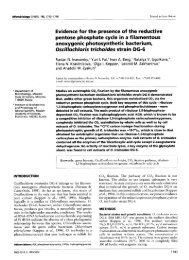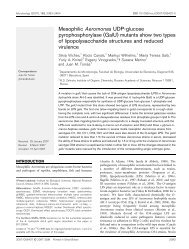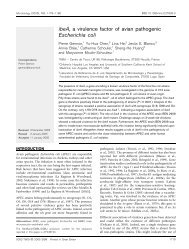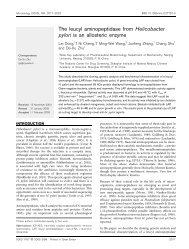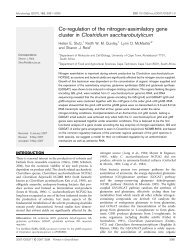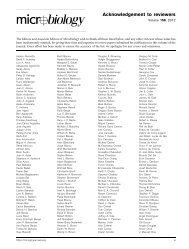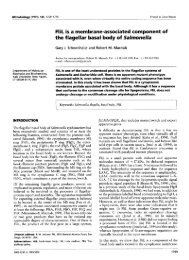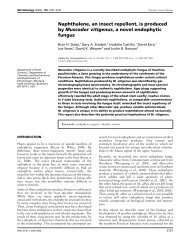Phylogenetic diversity of 'Endomicrobia' and their ... - Microbiology
Phylogenetic diversity of 'Endomicrobia' and their ... - Microbiology
Phylogenetic diversity of 'Endomicrobia' and their ... - Microbiology
Create successful ePaper yourself
Turn your PDF publications into a flip-book with our unique Google optimized e-Paper software.
<strong>Microbiology</strong> (2007), 153, 3458–3465 DOI 10.1099/mic.0.2007/009217-0<br />
Correspondence<br />
Andreas Brune<br />
brune@mpi-marburg.mpg.de<br />
Received 19 April 2007<br />
Revised 22 June 2007<br />
Accepted 27 June 2007<br />
INTRODUCTION<br />
‘Endomicrobia’ are a distinct <strong>and</strong> diverse group <strong>of</strong><br />
uncultivated bacteria in the c<strong>and</strong>idate phylum Termite<br />
Group I (TG-1) (Hugenholtz et al., 1998; Stingl et al.,<br />
2005). Originally discovered as members <strong>of</strong> the hindgut<br />
community <strong>of</strong> Reticulitermes speratus (Ohkuma & Kudo,<br />
1996; Hongoh et al., 2003), <strong>their</strong> occurrence seems to be<br />
restricted to the guts <strong>of</strong> phylogenetically lower termites <strong>and</strong><br />
wood-feeding cockroaches (Cryptocercus punctulatus)<br />
(Hongoh et al., 2005; Stingl et al., 2005; Yang et al.,<br />
2005). We have demonstrated previously that the<br />
‘Endomicrobia’ clones retrieved from Reticulitermes santonensis<br />
represent intracellular symbionts <strong>of</strong> flagellate protists<br />
(as previously proposed by Ohkuma et al., 2001), <strong>and</strong><br />
documented that the two major gut flagellates <strong>of</strong> this<br />
termite, Trichonympha agilis <strong>and</strong> Pyrsonympha vertens, each<br />
harbour a phylogenetically distinct lineage <strong>of</strong> ‘Endomicrobia’<br />
(Stingl et al., 2005).<br />
Termite gut flagellates are a unique group <strong>of</strong> protists<br />
consisting <strong>of</strong> more than 430 species, which have been<br />
3Present address: Oregon State University, Department <strong>of</strong> <strong>Microbiology</strong>,<br />
Nash Hall 220, Corvallis, OR 97331, USA.<br />
Abbreviations: FISH, fluorescence in situ hybridization; SSU, small<br />
subunit.<br />
The GenBank/EMBL/DDBJ accession numbers for the nucleotide<br />
sequence data reported in this paper are AB297984–AB298082,<br />
AB326107, AB326370–AB326383, AM747388 <strong>and</strong> AM747389.<br />
<strong>Phylogenetic</strong> <strong>diversity</strong> <strong>of</strong> ‘Endomicrobia’ <strong>and</strong> <strong>their</strong><br />
specific affiliation with termite gut flagellates<br />
Wakako Ikeda-Ohtsubo, Mahesh Desai, Ulrich Stingl3 <strong>and</strong> Andreas Brune<br />
Max-Planck-Institut für terrestrische Mikrobiologie, Karl-von-Frisch-Strasse, 35043 Marburg,<br />
Germany<br />
‘Endomicrobia’, a distinct <strong>and</strong> diverse group <strong>of</strong> uncultivated bacteria in the c<strong>and</strong>idate phylum<br />
Termite Group I (TG-1), have been found exclusively in the gut <strong>of</strong> lower termites <strong>and</strong> woodfeeding<br />
cockroaches. In a previous study, we had demonstrated that the ‘Endomicrobia’ clones<br />
retrieved from Reticulitermes santonensis represent intracellular symbionts <strong>of</strong> the two major gut<br />
flagellates <strong>of</strong> this termite. Here, we document that ‘Endomicrobia’ are present also in many<br />
other gut flagellates <strong>of</strong> lower termites. Phylogeny <strong>and</strong> host specificity <strong>of</strong> ‘Endomicrobia’ were<br />
investigated by cloning <strong>and</strong> sequencing <strong>of</strong> the small subunit rRNA genes <strong>of</strong> the flagellate <strong>and</strong> the<br />
symbionts, which originated from suspensions <strong>of</strong> individual flagellates isolated by micropipette.<br />
Each flagellate harboured a distinct phylogenetic lineage <strong>of</strong> ‘Endomicrobia’. The results <strong>of</strong><br />
fluorescent in situ hybridization with ‘Endomicrobia’-specific oligonucleotide probes corroborated<br />
that ‘Endomicrobia’ are intracellular symbionts specifically affiliated with <strong>their</strong> flagellate hosts.<br />
Interestingly, the ‘Endomicrobia’ sequences obtained from flagellates belonging to the genus<br />
Trichonympha formed a monophyletic group, suggesting co-speciation between symbiont <strong>and</strong><br />
host.<br />
described mostly on a morphological basis (Brugerolle &<br />
Lee, 2000; Yamin, 1979). <strong>Phylogenetic</strong> studies using smallsubunit<br />
(SSU) rRNA <strong>and</strong> other molecular markers have<br />
confirmed the presence <strong>of</strong> two distinct phylogenetic<br />
lineages, i.e. Oxymonadida <strong>and</strong> Parabasalidea (Dacks<br />
et al., 2001; Gerbod et al., 2002; Stingl & Brune, 2003;<br />
Ohkuma et al., 2005). Although little is known about the<br />
metabolic functions <strong>of</strong> termite gut flagellates (Brune &<br />
Stingl, 2005) – the majority <strong>of</strong> which are uncultivated –<br />
they are generally considered to play a major role in the<br />
cellulose metabolism <strong>of</strong> the hindgut (Yamin, 1980; Odelson<br />
& Breznak, 1985).<br />
Most termite gut flagellates are associated with prokaryotic<br />
symbionts, which colonize the cell surface, the cytoplasm<br />
or sometimes the nucleus <strong>of</strong> <strong>their</strong> hosts (Kirby, 1941;<br />
Berchtold et al., 1999; Brune & Stingl, 2005; Brune, 2006).<br />
The high frequency <strong>of</strong> such associations <strong>and</strong> an apparent<br />
specificity <strong>of</strong> the symbionts for <strong>their</strong> host flagellate (Noda<br />
et al., 2005, 2006; Stingl et al., 2004) are indicative <strong>of</strong> a<br />
functional significance <strong>of</strong> such symbioses for the termite<br />
gut ecosystem.<br />
The symbiosis between ‘Endomicrobia’ <strong>and</strong> termite gut<br />
flagellates might also represent such an intimate relationship,<br />
which has been supported by evidence that some<br />
‘Endomicrobia’ form host-specific associations with <strong>their</strong><br />
host flagellate (Stingl et al., 2005). Furthermore, the wide<br />
distribution <strong>and</strong> phylogenetic heterogeneity <strong>of</strong> ‘Endomicrobia’<br />
among lower termites harbouring various gut<br />
3458 2007/009217 G 2007 SGM Printed in Great Britain
flagellates (Stingl et al., 2005) collectively suggest a strong<br />
connection between the phylogenetic <strong>diversity</strong> <strong>of</strong> the<br />
symbionts <strong>and</strong> <strong>their</strong> flagellate hosts. We hypothesize here<br />
that the phylogenetic <strong>diversity</strong> <strong>of</strong> ‘Endomicrobia’ in the gut<br />
<strong>of</strong> lower termites reflects the <strong>diversity</strong> <strong>of</strong> <strong>their</strong> flagellate<br />
hosts. To test this hypothesis, we phylogenetically analysed<br />
SSU rRNA genes <strong>of</strong> the major flagellates <strong>and</strong> <strong>their</strong><br />
symbionts in the termite Hodotermopsis sjoestedti <strong>and</strong> in<br />
selected flagellates <strong>of</strong> five other termite species.<br />
METHODS<br />
Termites. Hodotermopsis sjoestedti was collected on Yakushima<br />
Isl<strong>and</strong>, Japan. Zootermopsis nevadensis was collected on Mt Pinos,<br />
Los Padres National Forest, California, USA. Cryptotermes secundus<br />
came from a mangrove forest near Darwin, Australia. Mastotermes<br />
darwiniensis, Kalotermes flavicollis <strong>and</strong> Neotermes castaneus were from<br />
cultures maintained at the Bundesanstalt für Materialforschung und<br />
-prüfung (BAM), Germany. In the laboratory, colonies were<br />
maintained in polyethylene containers at 25 uC on a diet <strong>of</strong><br />
pinewood. Only termite workers/pseudergates were used in the<br />
experiments.<br />
DNA extraction from whole hindguts. Ten hindguts were dissected<br />
using sterile forceps <strong>and</strong> pooled in 750 ml filter-sterilized sodium<br />
phosphate buffer (pH 8.0) in a polyethylene tube. The entire content <strong>of</strong><br />
the tube was transferred into a polyethylene screw-cap tube containing<br />
250 ml TNS solution (500 mM Tris/HCl, 100 mM NaCl, 10 % SDS,<br />
pH 8.0) <strong>and</strong> 0.7 g zirconium beads, <strong>and</strong> then homogenized in a<br />
FastPrep FP120 (Bio 101, Savant Instruments) for 45 s at 6.5 m s –1 . The<br />
homogenates were centrifuged, <strong>and</strong> DNA in the supernatant was<br />
purified by phenol/chlor<strong>of</strong>orm extraction <strong>and</strong> ethanol precipitation.<br />
DNA extraction from flagellates. The contents <strong>of</strong> three to seven<br />
hindguts were suspended in Solution U (Trager, 1934) <strong>and</strong> diluted to<br />
a density <strong>of</strong> approximately 10 flagellate cells ml –1 . Aliquots (20 ml) <strong>of</strong><br />
the diluted suspension were placed in the wells <strong>of</strong> a 10-well Tefloncoated<br />
glass slide (Erie Scientific Company). Flagellate cells were<br />
sorted by morphology (Radek et al., 1992; Tamm, 1999; Brugerolle &<br />
Bordereau, 2004), <strong>and</strong> 150–200 flagellate cells <strong>of</strong> each morphotype<br />
were collected by micropipette using an inverted microscope. The<br />
cells were collected into a well containing 15 ml sterile PBS <strong>and</strong><br />
washed by at least three transfers into fresh PBS-containing wells.<br />
Approximately 100 cells were finally resuspended in 200 ml sterile<br />
PBS. Cells were disrupted by three cycles <strong>of</strong> freeze–thawing, <strong>and</strong> DNA<br />
was extracted from each sample using the NucleoSpin kit (Macherey-<br />
Nagel), following the manufacturer’s instructions. The extracted DNA<br />
was finally eluted with 30 ml distilled water <strong>and</strong> used as a template for<br />
PCR reactions.<br />
PCR amplification. Flagellate SSU rRNA genes were amplified using<br />
universal eukaryotic primers as described by Keeling et al. (1998).<br />
Bacterial SSU rRNA genes were amplified using 27F (Edwards et al.,<br />
1989) <strong>and</strong> 1492R (Weisburg et al., 1991) as described by Henckel et al.<br />
(1999). ‘Endomicrobia’ SSU rRNA genes were amplified as previously<br />
described, using the forward primer TG1-209F (Stingl et al., 2005)<br />
<strong>and</strong> a slightly modified reverse primer TG1-1325R9 (59-<br />
GATTCCTACTTCATGTG-39).<br />
Cloning <strong>and</strong> sequencing. PCR products were ligated into plasmid<br />
pCR2.1-TOPO <strong>and</strong> introduced into E. coli TOP10F9 by transformation<br />
using the TOPO TA cloning kit (Invitrogen), following the<br />
manufacturer’s instructions. Clones with a flagellate SSU rRNA gene<br />
insert <strong>and</strong> clones with an ‘Endomicrobia’ SSU rRNA gene insert<br />
(~1070 bp) were screened by direct PCR using M13 primers. To<br />
obtain the almost-full-length ‘Endomicrobia’ SSU rRNA genes,<br />
bacterial SSU rRNA gene libraries (~1500 bp) were screened with<br />
‘Endomicrobia’-specific primers (see above). PCR products <strong>of</strong> the<br />
expected size were digested separately with the restriction enzymes<br />
MspI <strong>and</strong> AluI, <strong>and</strong> subjected to electrophoresis on a 3 % agarose gel.<br />
The clones were sorted according to <strong>their</strong> restriction patterns, <strong>and</strong><br />
two to ten representatives <strong>of</strong> each ribotype were sequenced using M13<br />
primer sets. For each phylotype (sequence clusters with more than<br />
1 % sequence divergence) obtained in this study, several representative<br />
SSU rRNA gene sequences have been submitted to GenBank<br />
under accession numbers AB297984–AB298082, AB326107,<br />
AB326370–AB326383 <strong>and</strong> AM747388–AM747389.<br />
<strong>Phylogenetic</strong> analysis. The SSU rRNA gene sequences were<br />
imported into the database implemented in the ARB s<strong>of</strong>tware package<br />
(Ludwig et al., 2004). The sequences were automatically aligned with<br />
the other closely related SSU rRNA sequences using the ARB<br />
Fast_Aligner, followed by manual refinement. <strong>Phylogenetic</strong> trees<br />
were constructed using almost-full-length SSU rRNA sequences<br />
(.1300 bases) by maximum-likelihood methods (AxML <strong>and</strong><br />
fastDNAml), <strong>and</strong> the stability <strong>of</strong> the tree topology was tested by the<br />
neighbour-joining <strong>and</strong> maximum-parsimony methods implemented<br />
in ARB. Shorter sequences were added using the ARB parsimony tool.<br />
Chimaeric sequences were identified using the Bellerophon server<br />
(Huber et al., 2004; http://foo.maths.uq.edu.au/~huber/bellerophon.<br />
pl) <strong>and</strong> by carefully checking for signature sequences in the<br />
alignment, <strong>and</strong> were subsequently removed from the dataset.<br />
Whole-cell in situ hybridization. Fixed gut contents were prepared<br />
<strong>and</strong> in situ hybridization was performed as described previously (Stingl<br />
& Brune, 2003). Probe EUB338 (Amann et al., 1990) <strong>and</strong> the nonsense<br />
probe NON338 (Wallner et al., 1993) were used to identify bacterial<br />
cells <strong>and</strong> to distinguish non-specific probe binding in the same<br />
suspension. For each probe, hybridization stringency was optimized by<br />
testing formamide concentrations over a range <strong>of</strong> 0–50 %.<br />
RESULTS<br />
Diversity <strong>and</strong> host specificity <strong>of</strong> ‘Endomicrobia’<br />
Host affiliation <strong>of</strong> ‘Endomicrobia’ in H. sjoestedti<br />
Clone libraries <strong>of</strong> SSU rRNA genes amplified from H.<br />
sjoestedti whole-gut DNA extract with ‘Endomicrobia’specific<br />
primers contained more than 10 distinct monophyletic<br />
lineages <strong>of</strong> ‘Endomicrobia’. To test whether<br />
individual phylotypes can be assigned to <strong>their</strong> host<br />
flagellates, suspensions were prepared by carefully picking<br />
individual flagellate cells according to <strong>their</strong> characteristic<br />
morphotypes. The major populations among the flagellate<br />
community were formed by species <strong>of</strong> the genus<br />
Dinenympha (Oxymonadida; Fig. 1a), Trichonympha <strong>and</strong><br />
Eucomonympha (both Parabasalidea; Fig. 1b, c). DNA<br />
extracted from the respective suspensions yielded PCR<br />
products <strong>of</strong> the expected length with eukaryotic (1500–<br />
1800 bp), bacterial (~1500 bp) <strong>and</strong> ‘Endomicrobia’-specific<br />
(~1100 bp) SSU rRNA primers.<br />
The eukaryotic SSU rRNA gene libraries prepared from the<br />
Eucomonympha <strong>and</strong> Dinenympha suspensions each contained<br />
a single phylotype (Table 1). In the library from the<br />
Eucomonympha suspension, the obtained sequence was<br />
virtually identical to that <strong>of</strong> clone HsL3 recovered in a<br />
clone library <strong>of</strong> a mixed flagellate population <strong>of</strong> H.<br />
http://mic.sgmjournals.org 3459
W. Ikeda-Ohtsubo <strong>and</strong> others<br />
Fig. 1. Light micrographs <strong>of</strong> ten flagellate species used in this study: Dinenympha sp. (a), Trichonympha sp. (b) <strong>and</strong><br />
Eucomonympha sp. (c) from H. sjoestedti; Trichonympha sp. (d) from Z. nevadensis; Deltotrichonympha sp. (e) from<br />
M. darwiniensis; Joenia sp. (f) from K. flavicollis; Devescovina sp. (g), Calonympha sp. (h) <strong>and</strong> Oxymonas sp. (i) from<br />
N. castaneus; <strong>and</strong> an unclassified parabasalid (j) from C. secundus. Bars, 50 mm.<br />
sjoestedti (Ohkuma et al., 2000), corroborating the tentative<br />
assignment <strong>of</strong> this clone to the genus Eucomonympha. In<br />
the case <strong>of</strong> the Dinenympha suspension, the sequence<br />
showed 94 % identity to that <strong>of</strong> a Dinenympha species from<br />
Reticulitermes hesperus (Moriya et al., 2003) <strong>and</strong> probably<br />
represents a new, hitherto unrecognized species <strong>of</strong><br />
Table 1. Phylotypes <strong>of</strong> flagellates recovered in the flagellate suspensions prepared from hindgut contents <strong>of</strong> different termite species<br />
<strong>and</strong> <strong>their</strong> closest relatives in public databases<br />
Termite species (family) Flagellate suspension (Order*) Flagellate<br />
phylotype<br />
(accession no.)<br />
Hodotermopsis sjoestedti<br />
(Termopsidae)<br />
Zootermopsis nevadensis<br />
(Termopsidae)<br />
Mastotermes darwiniensis<br />
(Mastotermitidae)<br />
Kalotermes flavicollis<br />
(Kalotermitidae)<br />
Neotermes castaneus<br />
(Kalotermitidae)<br />
Cryptotermes secundus<br />
(Kalotermitidae)<br />
*Affiliation is based on Ohkuma et al. (2005).<br />
DCalculated based on the aligned dataset using ARB.<br />
Closest relatives (accession no.) Sequence<br />
similarity<br />
(%)D<br />
Trichonympha<br />
HsTcA Trichonympha sp. HsL5 from H. sjoestedti 99.9<br />
(Trichonymphida)<br />
(AB326107) (AB032233)<br />
HsTcB Trichonympha sp. Hs8 from H. sjoestedti 99.5<br />
(AB326371) (AB032229)<br />
HsTcC Trichonympha sp. HsS9 from H. sjoestedti 99.6<br />
(AB326373) (AB032239)<br />
Eucomonympha<br />
HsEcA Eucomonympha sp. HsL3 from H. sjoestedti 99.0<br />
(Trichonymphida)<br />
(AB326375) (AB032231)<br />
Dinenympha (Oxymonadida) HsDnA Dinenympha sp. OS1 from R. hesperus<br />
94.0<br />
(AB326376) (AB092933)<br />
Trichonympha<br />
ZnTcA Trichonympha cf. collaris from Z. angusticollis 95.2<br />
(Trichonymphida)<br />
(AB326378) (AF023622)<br />
Deltotrichonympha<br />
MdDtA Deltotrichonympha operculata from<br />
99.5<br />
(Christamonadida)<br />
(AB326380) M. darwiniensis (AJ583379)<br />
Joenia (Cristamonadida) KfJeA<br />
(AB326381)<br />
Gut symbiont Kf5 from K. flavicollis (AF215857) 98.7<br />
Devescovina (Cristamonadida) NcDvA<br />
(AM747389)<br />
Devescovina sp. D16 from N. jouteli (X97974) 98.9<br />
Calonympha (Cristamonadida) NcClA<br />
(AM747388)<br />
Calonympha sp. B14 from N. jouteli (X97976) 98.5<br />
Oxymonas (Oxymonadida) NcOxA Oxymonas sp. Nk_U08 from N. koshunensis 94.5<br />
(AB326383) (AB092931)<br />
Unclassified parabasalid<br />
CsSnA Unclassified parabasalid from C. brevis<br />
96.1<br />
(Cristamonadida)<br />
(AF052699)<br />
3460 <strong>Microbiology</strong> 153
Dinenympha. The Trichonympha suspension yielded three<br />
different phylotypes <strong>of</strong> eukaryotic SSU rRNA genes, whose<br />
sequences were virtually identical to those <strong>of</strong> the three<br />
Trichonympha phylotypes previously obtained from this<br />
termite by Ohkuma et al. (2000).<br />
SSU rRNA gene libraries were constructed from the same<br />
flagellate suspensions using Bacteria-specific or ‘Endomicrobia’-specific<br />
primers. With either primer set, only a<br />
single phylotype <strong>of</strong> ‘Endomicrobia’ was recovered from the<br />
Dinenympha (‘Endomicrobia’ phylotype HsDn-1) <strong>and</strong><br />
Eucomonympha (HsEc-1) suspensions, whereas two distinct<br />
phylotypes (HsTc-1 <strong>and</strong> HsTc-2) were identified in<br />
the Trichonympha suspension. Each <strong>of</strong> the phylotypes<br />
formed a distinct, host-specific cluster (Fig. 2). Additional<br />
clusters consisting only <strong>of</strong> clones from whole-gut preparations<br />
were present (WG1–WG9, Fig. 2), suggesting that<br />
‘Endomicrobia’ might be present also in other flagellate<br />
species in H. sjoestedti other than those investigated.<br />
However, we do not completely preclude the possibility<br />
that these unidentified clones are derived from free-living<br />
‘Endomicrobia’ species.<br />
Diversity <strong>and</strong> host specificity <strong>of</strong> ‘Endomicrobia’<br />
‘Endomicrobia’ in representative flagellates from<br />
other termites<br />
Using the same strategy, we phylogenetically analysed the<br />
host flagellates <strong>and</strong> ‘Endomicrobia’ in the flagellate<br />
suspensions prepared from five other termites, which<br />
represent seven additional flagellate genera <strong>of</strong> parabasalids<br />
<strong>and</strong> oxymonadids (Table 1). Again, we were able to assign<br />
the eukaryotic SSU rRNA gene sequences obtained from<br />
each flagellate suspension to the identical or similar<br />
respective genera, whose SSU rRNA gene sequences have<br />
been published. A notable exception was the SSU rRNA<br />
gene recovered from the suspension <strong>of</strong> Joenia sp. <strong>of</strong> K.<br />
flavicollis, which showed the highest identity (98 %) to<br />
clone Kf5 (AF215857) obtained from a clone library <strong>of</strong> the<br />
same termite <strong>and</strong> assigned to the flagellate genus Foaina by<br />
other authors (Gerbod et al., 2000).<br />
Each <strong>of</strong> the flagellate suspensions yielded a single <strong>and</strong><br />
unique host-specific phylotype <strong>of</strong> ‘Endomicrobia’ in the<br />
corresponding SSU rRNA libraries. The phylogenetic tree<br />
<strong>of</strong> all almost-full-length (.1400 bp) SSU rRNA gene<br />
sequences obtained in this <strong>and</strong> previous studies clearly<br />
Fig. 2. <strong>Phylogenetic</strong> tree <strong>of</strong> ‘Endomicrobia’ <strong>and</strong> selected environmental clones in the TG-1 phylum, based on SSU rRNA gene<br />
sequences. The core tree (maximum-likelihood) was constructed from almost-full-length sequences (.1300 bp). Tree topology<br />
was tested by neighbour-joining <strong>and</strong> parsimony analysis with bootstrapping (DNAPARS, 1000 replicates). Marked nodes have<br />
bootstrap values <strong>of</strong> .95 % ($) <strong>and</strong> .50 % (#), nodes not supported by all analyses are shown as multifurcations. WG1–<br />
WG9: clusters formed by shorter (~1070 bp) ‘Endomicrobia’ sequences originating from whole-gut contents added using the<br />
ARB parsimony tool. Sequences obtained in this study are marked in bold.<br />
http://mic.sgmjournals.org 3461
W. Ikeda-Ohtsubo <strong>and</strong> others<br />
showed that the ‘Endomicrobia’ sequences from each<br />
flagellate host always represent distinct phylotypes (Fig. 2).<br />
The ‘Endomicrobia’ <strong>of</strong> flagellates originating from the<br />
same termite did not cluster with each other. Instead, the<br />
‘Endomicrobia’ from the Trichonympha species <strong>of</strong> H.<br />
sjoestedti <strong>and</strong> Z. nevadensis clustered together with those<br />
previously obtained from the Trichonympha species <strong>of</strong> R.<br />
santonensis <strong>and</strong> R. speratus, <strong>and</strong> collectively constitute a<br />
monophyletic cluster that forms a sister group <strong>of</strong> the<br />
‘Endomicrobia’ clones recovered from all other flagellates.<br />
Localization <strong>of</strong> ‘Endomicrobia’ by fluorescence in<br />
situ hybridization (FISH)<br />
For selected termites, we conducted FISH to confirm the<br />
intracellular location <strong>of</strong> the ‘Endomicrobia’ phylotypes<br />
obtained from the respective flagellate suspensions by the<br />
specific PCR amplification. It was not possible to design a<br />
specific probe for all ‘Endomicrobia’. Moreover, the<br />
limited number <strong>of</strong> variable regions among different<br />
‘Endomicrobia’ did not allow the design <strong>of</strong> specific probes<br />
covering each phylotype. Therefore, we designed a set <strong>of</strong><br />
oligonucleotide probes that covered the phylotypes in<br />
question (Table 2).<br />
Simultaneous FISH was conducted with a fluoresceinlabelled<br />
bacterial probe <strong>and</strong> a Cy3-labelled ‘Endomicrobia’<br />
probe. Fig. 3 shows representative examples in which the<br />
‘Endomicrobia’-specific signal is exclusively localized<br />
within the corresponding host cells, whereas the Bacteriaspecific<br />
probe also stained bacteria associated with the<br />
surface or content <strong>of</strong> these <strong>and</strong> other flagellate species<br />
(Fig. 3). In no case did we see evidence for the location <strong>of</strong><br />
‘Endomicrobia’ on the cell surface or within the nucleus <strong>of</strong><br />
the host.<br />
Since the morphotypes <strong>of</strong> certain flagellates (Dinenympha<br />
spp. in H. sjoestedti <strong>and</strong> Joenia sp. in K. flavicollis) were<br />
difficult to distinguish in the fixed samples, the presence <strong>of</strong><br />
‘Endomicrobia’ in the host cells was also confirmed by<br />
double hybridization with the respective combination <strong>of</strong><br />
host <strong>and</strong> symbiont probes (Table 2; details not shown). In<br />
the case <strong>of</strong> Eucomonympha cells, it was not possible to<br />
visualize single cells <strong>of</strong> ‘Endomicrobia’ because <strong>of</strong> a high<br />
affinity <strong>of</strong> both the Bacteria-specific <strong>and</strong> nonsense probe to<br />
the dense cell content <strong>of</strong> the host flagellate. Fluorescence<br />
signals outside <strong>of</strong> the flagellate cells observed in dry-wood<br />
termites (see Fig. 3f) were present also in non-stained<br />
preparations <strong>and</strong> were caused by aut<strong>of</strong>luorescence <strong>of</strong> wood<br />
particles in the gut content.<br />
DISCUSSION<br />
The results <strong>of</strong> this study corroborate that ‘Endomicrobia’<br />
are host-specific intracellular symbionts <strong>of</strong> termite gut<br />
flagellates. Each <strong>of</strong> the flagellates investigated harboured a<br />
unique phylotype <strong>of</strong> ‘Endomicrobia’, which supports our<br />
hypothesis that the <strong>diversity</strong> <strong>of</strong> ‘Endomicrobia’ in each<br />
termite gut reflects the <strong>diversity</strong> <strong>of</strong> <strong>their</strong> flagellate hosts.<br />
Potential co-speciation between endosymbiont <strong>and</strong> host is<br />
suggested by the ‘Endomicrobia’ phylotypes associated<br />
with flagellates <strong>of</strong> the genus Trichonympha constituting a<br />
monophyletic group.<br />
Each <strong>of</strong> the termite gut flagellates analysed in this study<br />
invariably harboured ‘Endomicrobia’. Together with the<br />
phylotypes that remain to be assigned to a particular host,<br />
‘Endomicrobia’ represent the symbionts <strong>of</strong> up to 24<br />
parabasalid <strong>and</strong> oxymonadid species, <strong>and</strong> probably more<br />
in view <strong>of</strong> the presence <strong>of</strong> ‘Endomicrobia’ phylotypes<br />
retrieved from whole-gut homogenates <strong>of</strong> H. sjoestedti in<br />
addition to those retrieved from the flagellate suspensions.<br />
The wide host range <strong>and</strong> <strong>their</strong> consistent occurrence within<br />
the host indicate a broad host spectrum <strong>of</strong> ‘Endomicrobia’<br />
as symbionts <strong>of</strong> termite gut flagellates.<br />
The ‘Endomicrobia’ <strong>of</strong> each flagellate species form a unique<br />
phylogenetic lineage. The case <strong>of</strong> H. sjoestedti, in which the<br />
Trichonympha suspension contained three phylotypes <strong>of</strong><br />
Table 2. Oligonucleotide probes newly designed for whole-cell hybridization <strong>of</strong> ‘Endomicrobia’ <strong>and</strong> <strong>their</strong> host flagellates<br />
Probe name Target* Sequence (5§–3§)D Formamide concn (%)<br />
TG1End1023T1 ‘Endomicrobia’ phylotypes ZnTc-1, HsTc-1, RsTG1 GCTGACTCCCTTGCGGGTCA 20–50<br />
TG1End1027 Most ‘Endomicrobia’ lineages (including HsDn-1) CTCTGCTAACTCCCTTGCGG 40<br />
TG1End1023 Some ‘Endomicrobia’ lineages (including HsEc-1) ACTAACTCCCTTGCGGGTCA 20d<br />
TG1-TriG1-Hsj Symbiont HsTc-1 <strong>of</strong> Trichonympha sp. HsTcA TTGGTCCAGAAGACTGCTT 20<br />
TG1-Joe-Kf Symbiont KfJe-1 <strong>of</strong> Joenia sp. KfJeA GCTAACTCTCTTGCGAGTCA 20<br />
TG1-Dev-Nca Symbiont NcDv-1 <strong>of</strong> Devescovina sp. NcDvA GCATAGGACCACAGTTTGGC 20<br />
Flg-Dine-Hsj Dinenympha sp. HsDnA <strong>of</strong> H. sjoestedti GCTTTTTGAGGCGGCTAT 35<br />
Flg-Tricho1-Hsj Trichonympha sp. HsTcA <strong>of</strong> H. sjoestedti GCTAGATTTCAAGATAGTCT 10<br />
Flg-Euc-Hsj Eucomonympha sp. HsEcA <strong>of</strong> H. sjoestedti AAACCTCCAGACCACGCT 10d<br />
Flg-Joe-Kfl Joenia sp. KfJeA <strong>of</strong> K. flavicollis GCTAGGTTGCACACTAGTGG 35<br />
*All ‘Endomicrobia’ probes had at least two mismatches against any other bacterial phylotype in public databases previously detected in termite guts.<br />
DThe oligonucleotide probe sequences have been submitted to probeBase (Loy et al., 2003; www.microbial-ecology.net/probebase/).<br />
dNot optimized.<br />
3462 <strong>Microbiology</strong> 153
Trichonympha, but from which only two distinct phylotypes<br />
<strong>of</strong> ‘Endomicrobia’ were recovered, does not necessarily<br />
contradict the proposed host specificity. It is possible<br />
that the third phylotype <strong>of</strong> ‘Endomicrobia’ was missed in<br />
this study because it had been under-represented in the<br />
sample, or that one <strong>of</strong> the three phylotypes <strong>of</strong><br />
Trichonympha in H. sjoestedti lacks ‘Endomicrobia’. The<br />
first explanation is supported by the presence <strong>of</strong> another<br />
‘Endomicrobia’ lineage (WG1) recovered from total-gut<br />
DNA that clusters with the two other lineages from the<br />
Trichonympha suspension (Fig. 2).<br />
All ‘Endomicrobia’ phylotypes associated with Trichonympha<br />
species collectively constitute a monophyletic group<br />
that is phylogenetically distinct from the phylotypes<br />
recovered from all other flagellates. The evidence that<br />
host-specificity is present also at the species level is<br />
indicative <strong>of</strong> co-speciation between the partners (Page &<br />
Charleston, 1998). This would imply that each <strong>of</strong> the extant<br />
Trichonympha flagellates harbours a specific lineage <strong>of</strong><br />
‘Endomicrobia’ inherited by vertical transmission from<br />
<strong>their</strong> common ancestor – an issue that cannot be resolved<br />
based on the current dataset. Conversely, it is possible that<br />
at one point in time ‘Endomicrobia’ have been horizontally<br />
transferred from one flagellate species to another within the<br />
same termite gut. This would explain why oxymonads<br />
(Dinenympha, Oxymonas) harbour ‘Endomicrobia’ that are<br />
Diversity <strong>and</strong> host specificity <strong>of</strong> ‘Endomicrobia’<br />
Fig. 3. Epifluorescence micrographs <strong>of</strong> hindgut<br />
preparations <strong>of</strong> Z. nevadensis (a, b), H.<br />
sjoestedti (c, d) <strong>and</strong> Devescovina from N.<br />
castaneus (e, f). The preparations were stained<br />
with DAPI (a, c, e) <strong>and</strong> simultaneously hybridized<br />
with the fluorescein-labelled (green)<br />
probe EUB338 <strong>and</strong> the Cy3-labelled (orange)<br />
probes TG1End1023T1 (b), TG1End1027<br />
(d), or TG1-Dev-Nca (f). Bacteria hybridizing<br />
with both probes appear yellow. Arrows (in f)<br />
indicate aut<strong>of</strong>luorescence <strong>of</strong> wood particles.<br />
Bars, 50 mm.<br />
relatively closely related to the symbionts <strong>of</strong> parabasalids,<br />
i.e. flagellates <strong>of</strong> a different phylum.<br />
This study corroborates that ‘Endomicrobia’ form a<br />
separate line <strong>of</strong> descent in the bacterial tree (Stingl et al.,<br />
2005). They are part <strong>of</strong> the TG-1 phylum, which consists<br />
<strong>of</strong> numerous diverse <strong>and</strong> deep-branching lineages<br />
(Herlemann et al., 2007). While ‘Endomicrobia’ seem to<br />
be restricted to termites <strong>and</strong> wood-feeding cockroaches,<br />
other representatives <strong>of</strong> the TG-1 phylum occur in a wide<br />
range <strong>of</strong> chemically <strong>and</strong> geographically distinct habitats,<br />
including soils, sediment <strong>and</strong> intestinal tracts.<br />
Although nothing is known about the metabolic function<br />
<strong>of</strong> ‘Endomicrobia’, <strong>their</strong> constant occurrence as intracellular<br />
symbionts with a broad host range suggests that <strong>their</strong><br />
nutritional requirements may be met by substances<br />
commonly available in the cytoplasm <strong>of</strong> gut flagellates.<br />
The host flagellates may also benefit from <strong>their</strong> endosymbionts,<br />
e.g. by the provision <strong>of</strong> nutrients otherwise lacking<br />
in the diet <strong>of</strong> the termites (see also: Stingl et al., 2005).<br />
Although certain termite gut flagellates have been shown to<br />
ferment cellulose to hydrogen <strong>and</strong> acetate (Hungate, 1955;<br />
Yamin, 1980, 1981; Odelson & Breznak, 1985), the<br />
physiology <strong>of</strong> most termite gut flagellates is still completely<br />
unknown. This makes elucidation <strong>of</strong> the biology <strong>of</strong><br />
‘Endomicrobia’ <strong>and</strong> <strong>their</strong> function in the symbiosis a most<br />
intriguing, but very challenging subject.<br />
http://mic.sgmjournals.org 3463
W. Ikeda-Ohtsubo <strong>and</strong> others<br />
ACKNOWLEDGEMENTS<br />
This work was supported by the Max Planck Society <strong>and</strong> by a<br />
fellowship <strong>of</strong> the Deutscher Akademischer Austauschdienst (DAAD)<br />
to W. I.-O. The authors are grateful to Ai Fujita, Horst Hertel, Judith<br />
Korb <strong>and</strong> Jared R. Leadbetter for providing some <strong>of</strong> the termites used<br />
in this study. We thank Renate Radek for the photomicrograph <strong>of</strong><br />
Deltotrichonympha operculata <strong>and</strong> Sibylle Frankenberg for the<br />
Oxymonas sp. SSU rRNA gene sequence.<br />
REFERENCES<br />
Amann, R. I., Krumholz, L. & Stahl, D. A. (1990). Fluorescentoligonucleotide<br />
probing <strong>of</strong> whole cells for determinative, phylogenetic,<br />
<strong>and</strong> environmental studies in microbiology. J Bacteriol 172, 762–770.<br />
Berchtold, M., Chatzinotas, A., Schönhuber, W., Brune, A., Amann, R.,<br />
Hahn, D. & König, H. (1999). Differential enumeration <strong>and</strong> in situ<br />
localization <strong>of</strong> micro-organisms in the hindgut <strong>of</strong> the lower termite<br />
Mastotermes darwiniensis by hybridization with rRNA-targeted probes.<br />
Arch Microbiol 172, 407–416.<br />
Brugerolle, G. & Bordereau, C. (2004). The flagellates <strong>of</strong> the termite<br />
Hodotermopsis sjoestedti with special reference to Hoplonympha,<br />
Holomastigotes <strong>and</strong> Trichomonoides trypanoides n. comb. Eur J<br />
Protistol 40, 163–174.<br />
Brugerolle, G. & Lee, J. J. (2000). Phylum Parabasalia, In An<br />
Illustrated Guide to the Protozoa, 2nd edn, vol. 2, pp. 1196–1250.<br />
Edited by J. J. Lee, G. F. Leedale & P. Bradbury. Lawrence, KS, USA:<br />
Society <strong>of</strong> Protozoologists.<br />
Brune, A. (2006). Symbiotic associations between termites <strong>and</strong><br />
prokaryotes. In The Prokaryotes, 3rd edn, vol. 1, Symbiotic Associations,<br />
Biotechnology, Applied <strong>Microbiology</strong>, pp. 439–474. Edited by M.<br />
Dworkin, S. Falkow, E. Rosenberg, K.-H. Schleifer & E. Stackebr<strong>and</strong>t.<br />
New York: Springer.<br />
Brune, A. & Stingl, U. (2005). Prokaryotic symbionts <strong>of</strong> termite gut<br />
flagellates: phylogenetic <strong>and</strong> metabolic implications <strong>of</strong> a tripartite<br />
symbiosis. In Molecular Basis <strong>of</strong> Symbiosis, pp. 39–60. Edited by<br />
J. Overmann. Berlin: Springer.<br />
Dacks, J. B., Silberman, J. D., Simpson, A. G. B., Moriya, S., Kudo, T.,<br />
Ohkuma, M. & Redfield, R. J. (2001). Oxymonads are closely related<br />
to the excavate taxon Trimastix. Mol Biol Evol 18, 1034–1044.<br />
Edwards, U., Rogall, T., Blöcker, H., Emde, M. & Böttger, E. C.<br />
(1989). Isolation <strong>and</strong> direct complete nucleotide determination <strong>of</strong><br />
entire genes. Characterization <strong>of</strong> a gene coding for 16S ribosomal<br />
RNA. Nucleic Acids Res 17, 7843–7853.<br />
Gerbod, D., Edgcomb, V. P., Noël, C., Delgado-Viscogliosi, P. &<br />
Viscogliosi, E. (2000). <strong>Phylogenetic</strong> position <strong>of</strong> parabasalid symbionts<br />
from the termite Calotermes flavicollis based on small subunit rRNA<br />
sequences. Int Microbiol 3, 165–172.<br />
Gerbod, D., Noël, C., Dolan, M. F., Edgcomb, V. P., Kitade, O., Noda, S.,<br />
Dufernez, F., Ohkuma, M., Kudo, T. & other authors (2002). Molecular<br />
phylogeny <strong>of</strong> parabasalids inferred from small subunit rRNA<br />
sequences, with emphasis on the Devescovinidae <strong>and</strong> Calonymphidae<br />
(Trichomonadea). Mol Phylogenet Evol 25, 545–556.<br />
Henckel, T., Friedrich, M. & Conrad, R. (1999). Molecular analyses <strong>of</strong><br />
the methane-oxidizing microbial community in rice field soil by<br />
targeting the genes <strong>of</strong> the 16S rRNA, particulate methane monooxygenase,<br />
<strong>and</strong> methanol dehydrogenase. Appl Environ Microbiol 65,<br />
1980–1990.<br />
Herlemann, D. P. R., Geissinger, O. & Brune, A. (2007). The Termite<br />
Group I phylum is highly diverse <strong>and</strong> widespread in the environment.<br />
Appl Environ Microbiol (in press).<br />
Hongoh, Y., Ohkuma, M. & Kudo, T. (2003). Molecular analysis <strong>of</strong><br />
bacterial microbiota in the gut <strong>of</strong> the termite Reticulitermes speratus<br />
(Isoptera, Rhinotermitidae). FEMS Microbiol Ecol 44, 231–242.<br />
Hongoh, Y., Deevong, P., Inoue, T., Moriya, S., Trakulnaleamsai, S.,<br />
Ohkuma, M., Vongkaluang, C., Noparatnaraporn, N. & Kudo, T.<br />
(2005). Intra- <strong>and</strong> interspecific comparisons <strong>of</strong> bacterial <strong>diversity</strong> <strong>and</strong><br />
community structure support coevolution <strong>of</strong> gut microbiota <strong>and</strong><br />
termite host. Appl Environ Microbiol 71, 6590–6599.<br />
Huber, T., Faulkner, G. & Hugenholtz, P. (2004). Bellerophon: a<br />
program to detect chimeric sequences in multiple sequence<br />
alignments. Bioinformatics 20, 2317–2319.<br />
Hugenholtz, P., Goebel, B. M. & Pace, N. R. (1998). Impact <strong>of</strong><br />
culture-independent studies on the emerging phylogenetic view <strong>of</strong><br />
bacterial <strong>diversity</strong>. J Bacteriol 180, 4765–4774.<br />
Hungate, R. E. (1955). Mutualistic intestinal protists. In Biochemistry<br />
<strong>and</strong> Physiology <strong>of</strong> Protists, vol. 2, pp. 159–199. Edited by S. H. Hutner<br />
& A. Lw<strong>of</strong>f. New York: Academic Press.<br />
Keeling, P. J., Poulsen, N. & McFadden, G. I. (1998). <strong>Phylogenetic</strong><br />
<strong>diversity</strong> <strong>of</strong> parabasalian symbionts from termites, including the<br />
phylogenetic position <strong>of</strong> Pseudotrypanosoma <strong>and</strong> Trichonympha.<br />
J Eukaryot Microbiol 45, 643–650.<br />
Kirby, H., Jr (1941). Organisms living on <strong>and</strong> in protozoa, In Protozoa<br />
in Biological Research, pp. 1009–1113. Edited by G. N. Calkins & F. M.<br />
Summers. New York: Columbia University Press.<br />
Loy, A., Horn, M. & Wagner, M. (2003). probeBase: an online resource for<br />
rRNA-targeted oligonucleotide probes. Nucleic Acids Res 31, 514–516.<br />
Ludwig, W., Strunk, O., Westram, R., Richter, L., Meier, H.,<br />
Yadhukumar, Buchner, A., Lai, T., Steppi, S. & other authors<br />
(2004). ARB: a s<strong>of</strong>tware environment for sequence data. Nucleic Acids<br />
Res 32, 1363–1371.<br />
Moriya, S., Dacks, J. B., Takagi, A., Noda, S., Ohkuma, M., Doolittle,<br />
W. F. & Kudo, T. (2003). Molecular phylogeny <strong>of</strong> three oxymonad<br />
genera: Pyrsonympha, Dinenympha <strong>and</strong> Oxymonas. J Eukaryot<br />
Microbiol 50, 190–197.<br />
Noda, S., Iida, T., Kitade, O., Nakajima, H., Kudo, T. & Ohkuma, M.<br />
(2005). Endosymbiotic Bacteroidales bacteria <strong>of</strong> the flagellated protist<br />
Pseudotrichonympha grassii in the gut <strong>of</strong> the termite Coptotermes<br />
formosanus. Appl Environ Microbiol 71, 8811–8817.<br />
Noda, S., Inoue, T., Hongoh, Y., Nalepa, C. A., Vongkaluang, C.,<br />
Kudo, T. & Ohkuma, M. (2006). Identification <strong>and</strong> characterization <strong>of</strong><br />
ectosymbionts <strong>of</strong> distinct lineages in Bacteroidales attached to<br />
flagellated protists in the gut <strong>of</strong> termites <strong>and</strong> a wood-feeding<br />
cockroach. Environ Microbiol 8, 11–20.<br />
Odelson, D. A. & Breznak, J. A. (1985). Nutrition <strong>and</strong> growth<br />
characteristics <strong>of</strong> Trichomitopsis termopsidis, a cellulolytic protozoan<br />
from termites. Appl Environ Microbiol 49, 614–621.<br />
Ohkuma, M. & Kudo, T. (1996). <strong>Phylogenetic</strong> <strong>diversity</strong> <strong>of</strong> the intestinal<br />
bacterial community in the termite Reticulitermes speratus. Appl<br />
Environ Microbiol 62, 461–468.<br />
Ohkuma, M., Ohtoko, K., Iida, T., Tokura, M., Moriya, S., Usami, R.,<br />
Horikoshi, K. & Kudo, T. (2000). <strong>Phylogenetic</strong> identification <strong>of</strong><br />
hypermastigotes, Pseudotrichonympha, Spirotrichonympha, Holomastigotoides,<br />
<strong>and</strong> parabasalian symbionts in the hindgut <strong>of</strong> termites. J<br />
Eukaryot Microbiol 47, 249–259.<br />
Ohkuma, M., Noda, N. S., Iida, T. & Kudo, T. (2001). Abstract<br />
P.15.006. In 9th International Symposium on Microbial Ecology,<br />
Amsterdam, 2001.<br />
Ohkuma, M., Iida, T., Ohtoko, K., Yuzawa, H., Noda, S., Viscogliosi, E.<br />
& Kudo, T. (2005). Molecular phylogeny <strong>of</strong> parabasalids inferred from<br />
small subunit rRNA sequences, with emphasis on the Hypermastigea.<br />
Mol Phylogenet Evol 35, 646–655.<br />
3464 <strong>Microbiology</strong> 153
Page, R. D. M. & Charleston, M. (1998). Trees within trees: phylogeny<br />
<strong>and</strong> historical associations. Trends Ecol Evol 13, 356–359.<br />
Radek, R., Hausmann, K. & Breunig, A. (1992). Ectobiotic <strong>and</strong><br />
endocytobiotic bacteria associated with the termite flagellate Joenia<br />
annectens. Acta Protozool 31, 93–107.<br />
Stingl, U. & Brune, A. (2003). <strong>Phylogenetic</strong> <strong>diversity</strong> <strong>and</strong> whole-cell<br />
hybridization <strong>of</strong> oxymonad flagellates from the hindgut <strong>of</strong> the woodfeeding<br />
lower termite Reticulitermes flavipes. Protist 154, 147–155.<br />
Stingl, U., Maass, A., Radek, R. & Brune, A. (2004). Symbionts <strong>of</strong> the<br />
gut flagellate Staurojoenina sp. from Neotermes cubanus represent a<br />
novel, termite-associated lineage <strong>of</strong> Bacteroidales: description <strong>of</strong><br />
‘C<strong>and</strong>idatus Vestibaculum illigatum’. <strong>Microbiology</strong> 150, 2229–2235.<br />
Stingl, U., Radek, R., Yang, H. & Brune, A. (2005). ‘Endomicrobia’:<br />
cytoplasmic symbionts <strong>of</strong> termite gut protozoa form a separate<br />
phylum <strong>of</strong> prokaryotes. Appl Environ Microbiol 71, 1473–1479.<br />
Tamm, S. L. (1999). Locomotory waves <strong>of</strong> Koruga <strong>and</strong> Deltotrichonympha:<br />
flagella wag the cell. Cell Motil Cytoskeleton 43, 145–158.<br />
Trager, W. (1934). The cultivation <strong>of</strong> a cellulose-digesting flagellate,<br />
Trichomonas termopsidis, <strong>and</strong> <strong>of</strong> certain other termite protozoa. Biol<br />
Bull 66, 182–190.<br />
Wallner, G., Amann, R. & Beisker, W. (1993). Optimizing fluorescent<br />
in situ hybridization with rRNA-targeted oligonucleotide probes for<br />
flow cytometric identification <strong>of</strong> microorganisms. Cytometry 14,<br />
136–143.<br />
Weisburg, W. G., Barns, S. M., Pelletier, D. A. & Lane, D. J. (1991). 16S<br />
ribosomal DNA amplification for phylogenetic study. J Bacteriol 173,<br />
697–703.<br />
Yamin, M. A. (1979). Flagellates <strong>of</strong> the orders Trichomonadida Kirby,<br />
Oxymonadida Grassé, <strong>and</strong> Hypermastigida Grassi & Foà reported<br />
from lower termites (Isoptera families Mastotermitidae, Kalotermitidae,<br />
Hodotermitidae, Termopsidae, Rhinotermitidae, <strong>and</strong><br />
Serritermitidae) <strong>and</strong> from the wood-feeding roach Cryptocercus<br />
(Dictyoptera: Cryptocercidae). Sociobiology 4, 3–119.<br />
Yamin, M. A. (1980). Cellulose metabolism by the termite flagellate<br />
Trichomitopsis termopsidis. Appl Environ Microbiol 39, 859–863.<br />
Yamin, M. A. (1981). Cellulose metabolism by the flagellate<br />
Trichonympha from a termite is independent <strong>of</strong> endosymbiotic<br />
bacteria. Science 211, 58–59.<br />
Yang, H., Schmitt-Wagner, D., Stingl, U. & Brune, A. (2005).<br />
Niche heterogeneity determines bacterial community structure in<br />
the termite gut (Reticulitermes santonensis). Environ Microbiol 7,<br />
916–932.<br />
Edited by: H. L. Drake<br />
Diversity <strong>and</strong> host specificity <strong>of</strong> ‘Endomicrobia’<br />
http://mic.sgmjournals.org 3465


